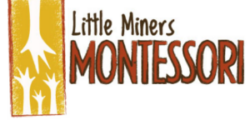by

1091 Beehive Drive
Park City, UT 84098
phone: (435) 940-1822
fax: (435) 649-4180
email: info@littleminers.org
6 to 9 years old
![]()
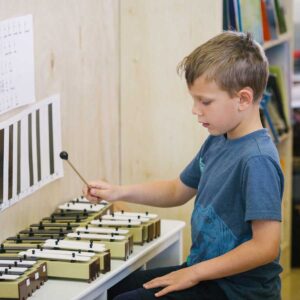
Full-Day: 8:30AM – 3:15PM
Full-Day (Monday – Friday)
$16,300
Field Trip Fee:
$300
3 to 6 years
![]()
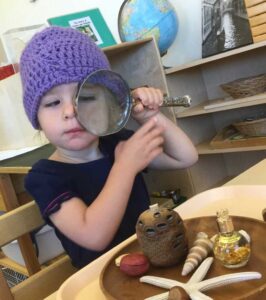
Half-Day: 8:30AM – 11:30AM or 12:30 – 3:30PM
Full-Day: 8:30AM – 3:30PM
Monday, Wednesday, Friday: $10,600
Tuesday, Thursday, Friday: $10,600
Monday – Thursday: $11,650
Monday – Friday: $12,810
Monday, Wednesday, Friday: $13,970
Tuesday, Thursday, Friday: $13,970
Monday – Thursday: $15,120
Monday-Friday: $16,280
Additional Lunch Hour (11:30-12:30PM)
1 day/week $45 monthly
2 days/week $75 monthly
3 days/week $95 monthly
4 days/week $105 monthly
5 days/week $115 monthly
18 months to 3 years old
![]()
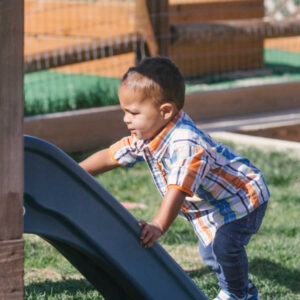
Half-Day: 8:30AM – 11:30AM
Full-Day: 8:30AM – 3:15PM
Monday, Wednesday, Friday: $11,650
Tuesday, Thursday, Friday: $11,650
Monday – Thursday: $12,800
Monday, Wednesday, Friday: $15,120
Tuesday, Thursday, Friday: $15,120
Monday-Thursday: $16,280
Monday-Friday: $17,430
(Early Childhood 3-6 yrs.) July 14-18
![]()

(Early Childhood 3-6 yrs.) July 21-25
![]()

(Lower Elementary 6-9 yrs.) July 7-11
![]()

Get ready for some magnificent adventures through land, seas, and time! Do you know who the brave and curious people were who set off on foot and by boat to discover new lands? Come join us to discover all about the Pacific Islanders, Sacagawea, and other Native American explorers like Ibn Buttuta and Marco Polo as well as archeological cave explorers and early geologists. Let us celebrate a week of discovery and fun!
(Lower Elementary 6-9 yrs.) July 14-18
![]()

Let us make some magic in the kitchen! Join us as we sift, measure, and mix it up for a week of deliciousness, while learning the science behind baking. At the end of the week, the children will host a bake sale with all of their baked goodies from the week…a mouth watering tummy fulfilling time!
(Lower Elementary 6-9 yrs.) July 21-25
![]()

Get ready to embark on an adventure that will have you seeing the world through a new lens, the lens of a botanist! Join us this week to become a plant detective at our Botany camp! Explore the fascinating world of plants, learn about their unique features, and discover how they grow and thrive. Let us get our hands dirty, conduct experiments, and create our own botanical masterpieces!
(Early Childhood 3-6 yrs.) July 7-11
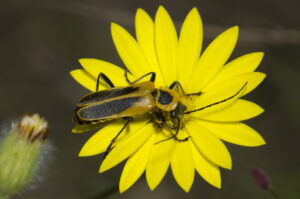
Lower Elementary
![]()

Redwood Classroom’s Spanish Enrichment Montessori Program
At Little Miner’s Montessori School, elementary children will be introduced to new Spanish content once a week. They will have opportunities for practice and repetition every day, in order to internalize that content. New content will be focused on a particular theme. Themes will alternate between everyday conversational language (such as foods, clothing, or parts of the body) and language that aligns with what the students are learning in the classroom (such as landforms, telling time, or vertebrates). Each theme will last for several weeks, with each lesson building on the vocabulary taught in the previous lesson. Over time, lessons will become more complex as students put together the vocabulary they’ve learned into simple phrases, and then complete sentences.
The Spanish program will use elements from three language teaching techniques:
When children are exposed to a foreign language in a fun, interactive way, with lots of opportunity for movement and repetition and without worrying about making mistakes, they thrive! I’m so excited to help LMM implement this program, and I look forward to working with the children in their journey to speak Spanish!
![]()
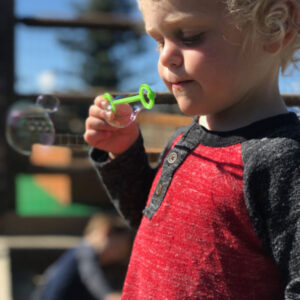
Let’s Talk Speech and Language Services provides private speech and language therapy to children and adolescents in Salt Lake City and Park City, Utah. We provide one-on-one treatment before, during and after school at many private schools in the area. We also provide in-home and in-office therapy as schedules permit. All of our speech pathologists are nationally certified through the American Speech-Language-Hearing Association (ASHA) and hold an active license in the State of Utah. Speech therapy treatment may include the areas of: speech and sound production (including articulation), resonance, voice, fluency, language, cognition and social language. We offer school-wide speech/language/hearing screenings through many private schools in the area.
You may consider having your child’s speech, language and hearing screened if your child shows one or more of the following:
• You suspect your child may have difficulty hearing
• Your child has a difficult time learning , using new concepts and vocabulary
• Your child has chronic ear infections
• You and others have a difficult time understanding your child’s speech or their speech is less intelligible than their peer’s
• Your child does not combine 2-5 words in their speech
• You suspect your child may have a fluency disorder (i.e. stuttering)
• Your child has difficulty asking and answering “wh” questions
• Your child becomes easily frustrated when trying to tell you something
https://littleminers.org/wp-content/uploads/2023/12/Speech-Language-Form-2.png
![]()
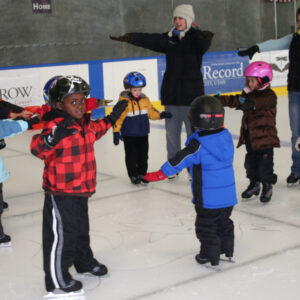
Little Miners is proud to offer a Learn-to-Skate Program through the Park City Ice Arena. Our students have the opportunity to sign up for a 6-week session (usually beginning on a Wednesday in March). Students will learn the basics of ice-skating, which include forward skating, gliding and stopping. They then progress to more advanced skills such as backward skating, swizzles and one-foot skating. Each session includes a 30-minute class and 30 minutes of practice time.
The cost of the program includes skate rental and 6 lessons. Parents are responsible for transporting their children to and from the ice arena. There will be a limited number of transportation spots available in the LMM van at an additional cost.
![]()
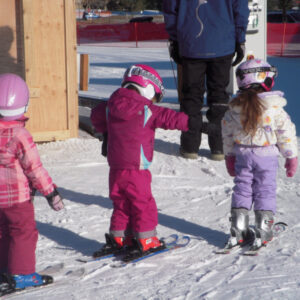
Little Miners offers a seven to eight week ski program beginning the first Friday in December each year. This program is an extra cost in addition to the yearly tuition. The program is held at Park City Mountain Resort from 9:30-11:30 A.M. The cost of the program includes a certified ski instructor and lift tickets. Each instructor has a maximum of 3 children who are grouped according to their ability.
In November, one month prior to the first ski lesson, parents are required to complete all the necessary paper work and submit to the office no later than the scheduled deadline. Parents needing transportation for their child are asked to sign-up in the office by filling out a Ski Program transportation form. An extra transportation cost will apply. Little Miners’ parents also help to transport children to and from the ski resort for this wonderful winter experience (limited space is available in the school van).
![]()
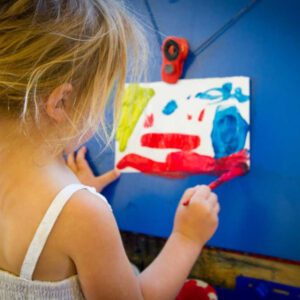
Every child who attends Little Miners, regardless of their schedule, is included in the art program once per week for 45 minutes. While the art program includes lessons and works modeled from the classroom curriculum, its main goal is to impart an independent set of art-specific concepts.
By taking into consideration the developmental skills that are being built in the classroom (cutting, holding a pencil, gluing, tracing, etc.) the art program strives to implement these skills in lessons that help the students develop age-appropriate art milestones outside of the classroom. New works are introduced to the art room weekly. Typically one of these new works will reflect either a theme being taught in the classroom or the letter of the week, and another will introduce a new art skill or medium.
While there are some craft-based projects (coloring in a template, making a holiday-related craft, etc.,) the art lessons are focused on the components of fine art: line, form, shape, texture, composition and color. The teaching philosophy within the art room stresses process over product. Students are encouraged to try new things and to form a dialogue about their process with the teacher and the other students.
![]()

The use of our hands, the pathway to our minds, is vital for memory, development, and intelligence. Control of movement, care of self, care of the environment, and grace and courtesy lessons pave a wondrous path for children to master many skills with their hands and bodies. They gain thoughtful and purposeful abilities to care for themselves, their community, and the world around them.
Practical Life
The great disconnect between people and industries such as, farming, textiles, cooking, sewing, and carpentry require a discerning awareness of the importance of these skills to develop independence, pride, self-worth, and social responsibility for future generations.
• Care of self (hygiene, nutrition, tying shoes, reflection and meditation, identifying emotions)
• Care of environment (classroom, cubbies, materials, school, community, earth)
• Care of classroom plants and animals
• Care of each other (class meetings, grace and courtesy lessons, relationship building, listening skills)
• Food preparation, setting a table, serving others
• Greeting visitors
• Helping others and working together
• Cooking
• Sewing
• Carpentry
• Gardening
![]()
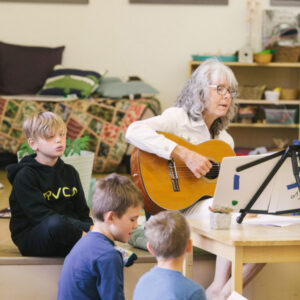
Art and music represent ways to communicate, ideas, imagination, culture, and humanity. Just as a child requires skills to write or dance or swim, she needs to also be given the tools and techniques to create her own masterpieces.
Art
As in all Montessori activities, elements and skills are broken down into clear segments to be studied, practiced, and mastered. Lines, shape, form, texture, and the rest of the elements of art are isolated and examined.
• Elements of art
• Aesthetic Education
• Aesthetic appreciation
Music
Music provides an outlet for all children, promoting math, language, coordination, and social skills. For children who may have difficulties in other areas may find their inner strengths through music, compelling them further in their journey of self-construction.
Through immersion and the creation of music children strengthen their brains, memory and develop higher order thinking skills but they also become more enlightened, compassionate individuals.
• Percussion instruments
• Tone bars
• Introduction of the musical staff
• Writing down music
• The Science of Sound
• Instrument classification
• Folk, classical, pop music
• Music vocabulary
• The musical lexicon
• Italian terms for tempo
![]()
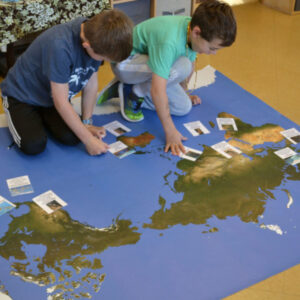
Both the history and geography curriculum reinforce and further cultivate a great sense of awe and gratitude for the planet and humankind by slowly and meticulously broadening a child’s awareness of community, environment, country, and human evolution and discovery throughout time.
The entire course of study is interwoven with the Great Lessons, through the power of stories, which inspire and encourage children to become stewards of the earth through discussions and meaningful interactions with beautiful materials.
History
The lessons assist children in discovering the what, why, how, and where inquiries they have a thirst in understanding. By offering a vivid and complete picture of human history children begin to understand and appreciate people, cultures, inventions and the fundamental needs of human kind
• Creation of the Universe
• Origins of the earth
• Creation stories from many cultures
• Earth history time-line (geological eras)
• Time-line of humans
• Fundamental needs of humans
• First civilizations
• Personal time-lines
• A year and its parts
• Calendars
• Clock of Eons
• Western civilizations
• United States history
• State history
• Eastern Civilizations
Geography
The child is given an epic and grand impression of the earth and the interconnected universe, providing a design which they may use to construct a well-rounded and intelligent view and love for all life and life forces. Geography then becomes not just about landforms but how they were formed, how they have changed, how they have been used and how they have influenced animals and people. Maps of countries become more than just names and capitals but become a subject to study history, flags, culture, people, explorers, cartographers, mathematicians and many more interesting and limitless subjects which are at the child’s disposal.
• A globe and its parts
• Orientation of globes to maps
• Land and water forms identification
• Biomes
• Parts of the mountain
• Parts of a river
• Parts of a coast
• Parts of a volcano
• Types of mountains, rivers, coasts and volcanoes
• Continents, countries, states, cities
• Flags; their parts meanings and history
• Maps and globes (directions, latitude/longitude)
• Legends and keys
• Study of a nation
![]()

The goal of the Montessori science curriculum is to provide children the opportunity to interact with, explore, categorize, experience, understand, and inquire about the many forms of life and energy surrounding them. A child gains thorough knowledge and gratitude through discovery, observation, examination, vocabulary, and correlation.
Biology, botany, physiology, and all the sciences embody the fundamental study of the Coming of Life and correlate to the other areas of study in the classroom in obvious and not so obvious but equally significant ways. Children are fascinated and drawn toward the natural world. Interest of other subjects is sparked through the enthusiastic and powerful channel of their natural and wondrous environment.
Botany
The child explores the world of plants, their unique features, parts, functions, and importance.
• Study of the five kingdoms
• Classification of plants
• Parts of plants
• Specialization of plants
• Plant experiments
• Plants we eat and use
• Life cycle of plants
• Plant adaptations
• Care of plants
• Research of plants
Zoology
In depth discussions and studies with hands-on care of animals provide endless opportunities for research, interest, and curiosity. External and internal parts of animals are studied giving in-depth knowledge and understanding of order, class and species. Characteristics, adaptations and specializations provide insight into the similarities, differences and unique challenges all life encounters in order to survive and flourish.
• Living vs. non-living
• Vertebrate/invertebrate
• Animal stories
• First knowledge of animals
• Classification of animals (phyla, class, order)
• Internal and external parts of vertebrates
• Comparisons of vertebrates
• Study of the human body
• Study of the invertebrate classes and orders
• Internal and external parts of invertebrates
• Comparisons of invertebrates
• Research on animals from the time-line of life and their adaptations
Earth Science
The study of the earth provides children an understanding and appreciation for our unique planet within our solar system and its connection with the sun, the family of planets, and the entire universe.
• Composition of the earth
• Planets and orbits
• Plate tectonics
• Seasons/weather/erosion
• Volcanoes/rocks/minerals
• Water cycle/atmosphere
• Fossils
• Biomes
Physical Science/Chemistry
Through experimentation, classification and observation children gain a solid understanding of the scientific method, research techniques, methods of observation, critical thinking, and problem solving.
• Simple machines
• Electricity
• Magnetism
• Gravity
• Buoyancy
• Inertia
• Motion
• Light
• Sound
• Flight
• Three states of matter
• Forces
• Atoms/molecules
• Protons/neutrons/electrons
• Periodic table
![]()
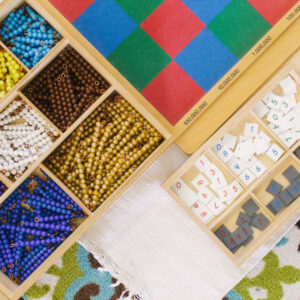
A carefully sequenced progression of mathematical activities from concrete to more abstract materials, simple to increasingly complex operations and lastly, tools for memorization of facts ensure a child’s whole brain development. The process and problem solving are first and foremost. Movement, active participation, and opportunities to problem solve, stimulate all four lobes of the brain, and nourish the child’s interest. Dr. Montessori created math materials that spark the imagination of the eagerly curious child.
Mathematical concepts are learned with ease and true understanding because the materials and lessons connect the hand and the mind in a most crucial and powerful way.
Numeration
Children develop a solid understanding of numbers, the decimal system and important concepts that relate to numbers and patterns.
• Numbers 0-10
• Odd and even numbers
• Teen numbers
• Tens numbers
• Counting 1-100
• Writing and reading small and large numbers
• Research of ten
• Hierarchy of numbers/association of symbol and quantity
• Decimal system with golden beads and the stamp game
• Linear and skip counting up to 1000
• Hierarchy of numbers
• Fractions: equivalency/entomology
• Quantities and symbols to the 1,000th
• Fraction and power equivalencies
Operations
Beginning with very concrete materials the child develops a deep understanding of numbers, their patterns and properties. Working with these materials through exploration, operations, and movements, the child is able to move towards abstraction in a meaningful and enjoyable way.
• Static and dynamic addition
• Static and dynamic subtraction,
• Static and dynamic multiplication
• Static and dynamic division
• Associative/distributive properties
• Math operations with decimals/fractions
• Word problems
Memorization
Through key lessons and specially designed materials, children work towards memorization of math facts and operations.
• Snake game
• Special cases of math operations
• Addition/subtraction strip boards
• Finger charts
• Dissociative/cumulative properties
• Inverse products
• Multiplication/division boards
• Bingo games for all operations
• Bead chains for skip counting and multiplication
• Binomials
• Analysis of a square
Geometry
Montessori philosophy and geometry curriculum speaks to the whole child bringing the communication and energy of the universe into cognizance. In turn, the child advances ever closer to abstraction. Initiation of the study of geometry is the introduction of the triangle, circle, along with the square. These figures are isolated in order to present to the child representations of shapes found in nature.
A child’s interest in architecture, art history, science, culture, mathematics, music and well, pretty much anything can be ignited through the thoughtful, appealing materials and lessons in geometry.
• Sensorial exploration of constructive triangles
• Sensorial exploration of the geometric cabinet(circles, squares, polygons)
• Geometric solids (cube, prisms, pyramids, spheres)
• Geometric terms (solid, surface, line, point)
• Planes and solids
• Regions and figures (polygons, closed curve, crossed, convex, concave)
• Types of lines
• Parts of the line
• Study of triangles (types, angles, sides, parts, terms)
• Measurements of angles/fractions
• Study of polygons, circles, quadrilaterals
• Congruence/equivalency/similarity
• Volume and area
![]()
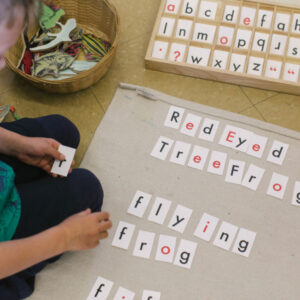
The Montessori elementary language arts curriculum offers a unique and effective method of introducing and engaging children in reading, writing, literature, sentence analysis and mechanics of the English language.
The foundation is set for a strong awareness of speech and distinguishing sounds in the early childhood years. Building upon this foundation, the lower elementary Montessori materials provide exciting, thought provoking key lessons along with a variety and multitude of materials that correspond to the objective of the lesson.
Children are an integral and active part of each lesson, dissimilar to the methods of teaching language in traditional schools where learning is passive and abstract.
Our spoken and written languages have a most incredible and enchanting history. These symbolic stories are presented to the lower elementary class and in turn, intrigue and excite the children to understand and seek more knowledge of the people that came before and influenced who we are today.
Attentive listening/communication/presentation skills
Activities, lessons and assignments help develop skills in oral communication, fluency and language.
• Grace and courtesy
• Teacher presentations
• Class meetings
• Projects and presentations
• Shared assignments
Reading
A variety of literary forms including fiction and non-fiction give the child an appreciation for many types of reading materials. Children are introduced to many comprehension strategies.
• Phonics
• Long and short vowels
• Consonant blends
• Diagraphs/diphthongs
• Sight words
• Reading sentences
• Reading paragraphs
• Reading stories
• Research text
• Poetry
• Reading in pairs
• Reading comprehension
• Library skills
Writing Mechanics
Children are exposed and given many opportunities to examine and practice creative writing using a variety of techniques, purposes, skills and materials.
• Creative, journal, letter, report, and story writing
• Editing
• Sentence structure
• Paragraphs
• Capitalization and punctuation
• Understanding and introducing main events, settings, and characters
• Sequencing and flow
Spelling
Children are given strategies and rules for spelling and decoding words with many opportunities for memorization.
• Moveable alphabet
• Inventive spelling
• Phonics and syllables
• Spelling lists, books and tests
• Alphabetical order
• Dictation
Word Study
Children are exposed to the wonderful world of words, their etymology and many uses. They learn how words are constructed, and expressed leading to an ever-increasing vocabulary and understanding of words, language, and history.
• Compound words
• Singular/plural
• Word families
• Root words, prefixes and suffixes
• Synonyms/antonyms
• Homonyms/homophones/homographs
• Syllabication/contractions
• Abbreviations/acronyms/capitalization
• Similes/metaphors
• Onomatopoeia/oxymoron
• Idioms/euphemisms
• Alliteration/assonance/consonance
• Dictionary/thesaurus/encyclopedia/atlas
Grammar
The grammar curriculum offers children a unique and engaging method for learning the function of words and language expression.
• Functions of words
• Parts of speech
• Logical analysis
• Fundamental tenses of verbs
• Sentence analysis
• Grammar symbols
Handwriting
Fine motor skills and proper formation of both print and cursive letters are key to proper and legible handwriting. There are many opportunities and assignments that encourage and assist in developing this important skill.
• Metal insets
• Letter formation (upper and lower case)
• Transcriptions
• Spacing
• Placement on the line
Writing various texts
Poetry
• Haiku
• Alliteration
• Acrostic
• Rhyme
• Found Poetry
• Concrete Poetry
• Onomatopoeia
• Limerick
• Cinquain
• Simile
Story Writing
• Lists
• Characters
• Settings
• Fairy Tales
• Finding Ideas
• Plot
• Linear
• Cumulative
• Parallel Plots
• Post Modern
• Circle Stories
Informational Texts
• Research
• Postcards
• Journal
• Autobiography
• Informational-Explanatory text
• Persuasive
![]()

Info coming soon.
![]()
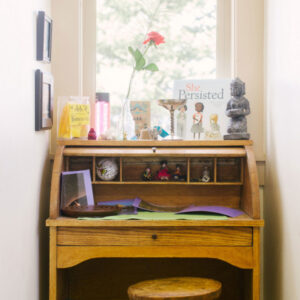
The key ingredient that binds the Montessori curriculum together and represents an anomalous educational entity is peace education. A profound respect for all life-forms, cultures, history, nature, community are instilled in the Montessori classroom. Nurturing the inner spirit of children and awakening them to the beauty and complexity of the universe encourages peace. Children are the preservers of culture and children are the transformers of culture.
• Grace and courtesy lessons
• Inclusion, respecting and appreciating differences
• Meditation and reflection exercises
• Appreciation circles
• Conflict resolution skills
• Team-building games
• Multiple studies of peace makers throughout history
![]()
 Respect, peacemaking, and conflict resolution are a daily part of the Montessori classroom. There is a Peace Table with beautiful, calming, enticing objects from around the world. The children touch and hold the objects and gain insight into their differing emotions. The Peace Table holds a peace object for children to use in resolving conflicts and encourages children to be good listeners and forge a mutually agreeable solution. It is also a place for children to enjoy a peaceful moment alone.
Respect, peacemaking, and conflict resolution are a daily part of the Montessori classroom. There is a Peace Table with beautiful, calming, enticing objects from around the world. The children touch and hold the objects and gain insight into their differing emotions. The Peace Table holds a peace object for children to use in resolving conflicts and encourages children to be good listeners and forge a mutually agreeable solution. It is also a place for children to enjoy a peaceful moment alone.
![]()
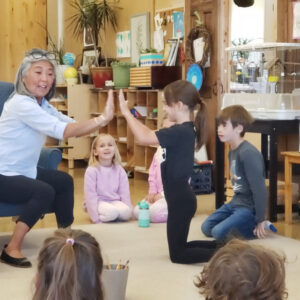
Little Miners is pleased to offer students the opportunity to learn Spanish as a second language. Ms. K is a trilingual teacher who has taught English, Japanese, and Spanish as a second language for decades. She was brought up in an immersive environment and school system (English and Japanese) and Spanish came into her life at the age of 12. She continues to teach/tutor the three languages to students in Park City as well as independent schools in Salt Lake valley. Forthwith, Miss K has been contracted with LMM since 2020.
At Little Miner’s K meets with Aspen, Birch, Willow, Poplar, and Maple classes once a week for 45 minutes. The Lower Elementary class meets twice a week. Miss K has an energetic style and is action-packed. She touches on all learning styles (kinesthetic, visual, aural, social, solitary, logical, and verbal) so that She can reach and accommodate all types of learners. Students are constantly engaged with chanting, singing, reciting, repeating, and movement. Spanish children’s songs, many times with actions, are introduced to them via very short (2-minute max) YouTube video clips. The fun visuals and catchy songs are learned fastest via this method. Please be assured that these video clips are all VERY age appropriate and are only used sparingly for teaching the songs. As a result, once they intuitively acquire the meaning of the song, we frequent the songs without the clips.
Literacy is introduced early in Early Childhood classes. While working on their letter recognition in English during their school day, the young student is simultaneously learning the alphabet sounds in Spanish. Crossing over in two languages has been proven to be very effective for the young brain. The vocabulary sheets that come home are always accompanied by an action for the word. Many of the students have already mastered the vocabulary words we have learned this far because we always incorporate movement in a fun way.
As Spanish class can often be exciting and energetic, we always practice mindfulness at the end of our sessions to bring down our energy level. Miss K calls their mindfulness practice “balloon breathing” with toddler classes (their bellies are balloons), breathing exercises with early childhood friends, and meditation for the lower elementary friends. Class management is never an issue thanks to their ability to regulate their energy level and emotions. They are all amazing breathers and peace seekers.
Should you ever be curious about what our Spanish classes are like, please feel free to drop in at any time for observation. You are more than welcome! All Little Miners are enthusiastic and participatory; you will be delighted to see them in action!
greetings song
months song
counting in 10s song
5 patitos
De que color es (longest clip = 4 minutes)
![]()
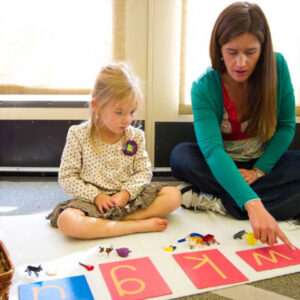 This is the culminating year of the Early-Childhood cycle which provides an extraordinary opportunity for the 5 and 6 year-olds to develop their leadership skills. Kindergartners act as positive peer models for their younger classmates. They enjoy their positions of responsibility that further strengthen their own capabilities and self-esteem. Everything that children have learned in the previous years as a Montessori student, come together in the Kindergarten year. These children are ready to meet new challenges with confidence and determination.
This is the culminating year of the Early-Childhood cycle which provides an extraordinary opportunity for the 5 and 6 year-olds to develop their leadership skills. Kindergartners act as positive peer models for their younger classmates. They enjoy their positions of responsibility that further strengthen their own capabilities and self-esteem. Everything that children have learned in the previous years as a Montessori student, come together in the Kindergarten year. These children are ready to meet new challenges with confidence and determination.
![]()
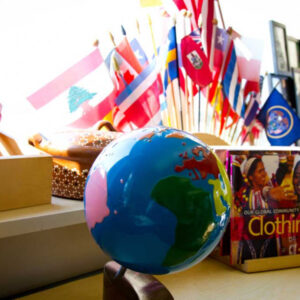 Geography in the Montessori classroom is a true celebration of the world’s diversity as well as it’s common threads. Children gain a deeper global perspective as they are introduced to land forms, continents, and study of the earth’s formation. The Geography curriculum begins with the two hemispheres of the Earth and becomes more detailed as children learn about the continents and the countries.
Geography in the Montessori classroom is a true celebration of the world’s diversity as well as it’s common threads. Children gain a deeper global perspective as they are introduced to land forms, continents, and study of the earth’s formation. The Geography curriculum begins with the two hemispheres of the Earth and becomes more detailed as children learn about the continents and the countries.
Children begin their study of the Earth at a very young age by using the wooden puzzle maps as puzzles. As they get older, the children use the puzzles to make their own maps and label them with their own handwriting. Not only can children learn the continent’s physical boundaries, but can also immerse themselves in the continent’s cultures, daily life, art, music, dance, food, religion, and literature.
![]()
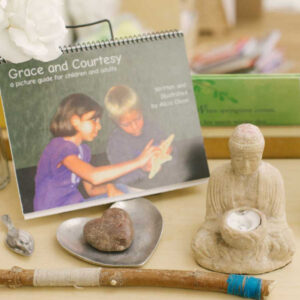 Perhaps the most critical life skill of all for children to master is the ability to work and play with others in a peaceful and caring way. Treating others with dignity and respect are cornerstones of the Montessori philosophy and are taught through Grace and Courtesy exercises.
Perhaps the most critical life skill of all for children to master is the ability to work and play with others in a peaceful and caring way. Treating others with dignity and respect are cornerstones of the Montessori philosophy and are taught through Grace and Courtesy exercises.
In the Montessori classroom, children and adults take care to be gracious toward, and courteous of, one another. This area encourages respect for oneself, for other members of the community, for all living things, and for the environment. Carrying things carefully, returning them to their place so others may use them, moving gracefully and carefully, using polite and respectful language, good table manners, and interrupting politely are all part of the lessons in Grace and Courtesy.
![]()
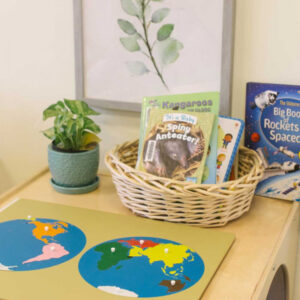 The Cultural area of the Montessori classroom can and should be as broad and varied as the world in which we live. Cultural Studies extend into the Practical Life, Sensorial, Math, and Language areas of the classroom and allow for further exploration with interesting and unique activities. The Cultural Area includes music, art, geography, history, ecology, geology, botany, zoology, and the physical sciences. These “key experiences” provide the child with a sense of wonder through sensorial experiences, literature, music, activities, and artifacts from all around the world. The Montessori classroom encourages exploration and curiosity to define a sense of self and the spirit of the people of the world.
The Cultural area of the Montessori classroom can and should be as broad and varied as the world in which we live. Cultural Studies extend into the Practical Life, Sensorial, Math, and Language areas of the classroom and allow for further exploration with interesting and unique activities. The Cultural Area includes music, art, geography, history, ecology, geology, botany, zoology, and the physical sciences. These “key experiences” provide the child with a sense of wonder through sensorial experiences, literature, music, activities, and artifacts from all around the world. The Montessori classroom encourages exploration and curiosity to define a sense of self and the spirit of the people of the world.
The goals of Cultural studies include exposing the child to a wide variety of subjects and experiences; stimulate the child’s natural curiosity; provide a sensorial experience for key concepts; provide language and vocabulary for these subjects; and lead the child to an awareness of the interrelatedness of people, plants, and animals around the world.
![]()
 The early childhood Math curriculum presents concepts through sequential concrete materials. These materials allow the child the opportunity to manipulate, experiment and invent over and over again. This encouragement for repetition leads to internalization of abstract concepts inherent in these Math materials and better understanding of these concepts.
The early childhood Math curriculum presents concepts through sequential concrete materials. These materials allow the child the opportunity to manipulate, experiment and invent over and over again. This encouragement for repetition leads to internalization of abstract concepts inherent in these Math materials and better understanding of these concepts.
The goals of the Mathematics area are to develop a child’s thought-process through organization and categorization; give the child a concrete impression of quantities and processes in math; aid the child in connecting the symbols and language of mathematics; help the child gradually internalize the abstract concepts; and facilitate the child’s memorization of mathematical facts.
Shapes and names of geometric figures
![]()
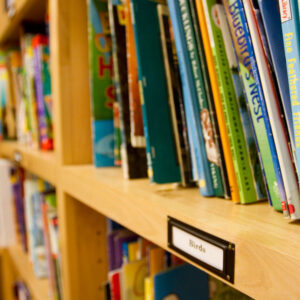 Maria Montessori observed that the potential exists for children to develop the higher language skills of reading and writing with the same ease with which they acquire oral speech. This “explosion” into literacy occurs naturally in the primary years if children are presented with the tools and experiences needed to nourish this organic inclination to learn.
Maria Montessori observed that the potential exists for children to develop the higher language skills of reading and writing with the same ease with which they acquire oral speech. This “explosion” into literacy occurs naturally in the primary years if children are presented with the tools and experiences needed to nourish this organic inclination to learn.
The goals of the Language Materials are for the child to develop a rich vocabulary and a strong foundation in phonetics. A child’s natural desire to read and express her thoughts through writing are stimulated. An appreciation for the rhythm and beauty of language through literature and poetry is instilled.
![]()
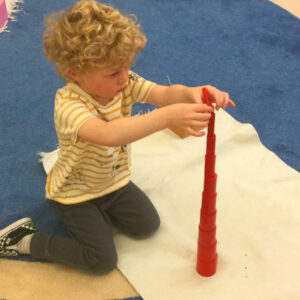 The Sensorial materials are critical for academics in the Montessori classroom. These activities begin with the youngest children in the class. Through various extensions and games they remain interesting to even the oldest children. The Sensorial materials build on the Practical Life activities and prepare the child for math and language through lessons in observation and problem solving.
The Sensorial materials are critical for academics in the Montessori classroom. These activities begin with the youngest children in the class. Through various extensions and games they remain interesting to even the oldest children. The Sensorial materials build on the Practical Life activities and prepare the child for math and language through lessons in observation and problem solving.
The goals of the Sensorial Area are to strengthen and refine each of the child’s senses and pincer grasp, develop a rich vocabulary, and provide for the internalization of Sensorial images. These materials guide children to observe, compare, make distinctions, and learn to think and reason.
Learning qualities of size, shape, color and dimension through these materials:
![]()

These are the first exercises introduced to the children. They create the foundation upon which all other work in the classroom depends. Practical Life exercises include care of self and the environment, as well as the development of large and fine motor control. These practical experiences in everyday activities are the cornerstone of the Montessori Method.
The focus of the Practical Life area is to develop coordination, independence, a sense of order, and above all, concentration.
• Pulling out a chair/ carrying a tray carefully
• Rolling a mat
• Walking purposefully
• Making silence
• Wet and dry pouring
• Spooning, tweezing, scooping, squeezing
• Opening and closing using various containers
• Cutting, peeling, grating, serving various types of foods
• Respect for self
• Personal care
• Hand washing
• Dressing frames
• Sorting
• Cleaning and polishing
• Carefully returning work back to original place and order
• Rolling a mat nicely and pushing in a chair
• Showing respect for materials
• Dusting, sweeping, polishing, folding, sponging
• Raking, digging, watering
• Recycling and gardening
• Choosing and performing class jobs
• Caring for animals and plants
• Manners and respect toward others
• Classroom and table manners
• Waiting for turns
• Being polite and respecting each other
• Helping others, sharing, caring for others
• Quiet voices and listening
• Peaceful problem solving with peace object such as a peace flower or peace rock
![]()
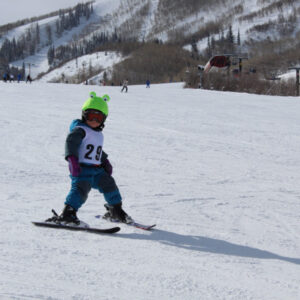 Little Miners offers Yoga, Ski, Ice Skating, Stretch & Grow, as well as plenty of outdoor time.
Little Miners offers Yoga, Ski, Ice Skating, Stretch & Grow, as well as plenty of outdoor time.
![]()
 Info Coming Soon.
Info Coming Soon.
![]()
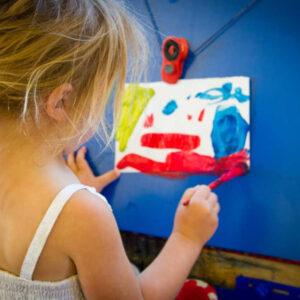 Art and music represent ways to communicate, ideas, imagination, culture, and humanity. Just as a child requires skills to write or dance or swim, she needs to also be given the tools and techniques to create her own masterpieces.
Art and music represent ways to communicate, ideas, imagination, culture, and humanity. Just as a child requires skills to write or dance or swim, she needs to also be given the tools and techniques to create her own masterpieces.
![]()
 Both the history and geography curriculum reinforce and further cultivate a great sense of awe and gratitude for the planet and humankind by slowly and meticulously broadening a child’s awareness of community, environment, country, and human evolution and discovery throughout time.
Both the history and geography curriculum reinforce and further cultivate a great sense of awe and gratitude for the planet and humankind by slowly and meticulously broadening a child’s awareness of community, environment, country, and human evolution and discovery throughout time.
The entire course of study is interwoven with the Great Lessons, through the power of stories, which inspire and encourage children to become stewards of the earth through discussions and meaningful interactions with beautiful materials.
![]()
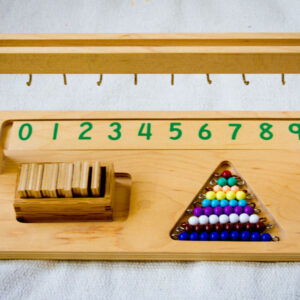 A carefully sequenced progression of mathematical activities from concrete to more abstract materials, simple to increasingly complex operations and lastly, tools for memorization of facts ensure a child’s whole brain development. The process and problem solving are first and foremost. Movement, active participation, and opportunities to problem solve, stimulate all four lobes of the brain, and nourish the child’s interest. Dr. Montessori created math materials that spark the imagination of the eagerly curious child.
A carefully sequenced progression of mathematical activities from concrete to more abstract materials, simple to increasingly complex operations and lastly, tools for memorization of facts ensure a child’s whole brain development. The process and problem solving are first and foremost. Movement, active participation, and opportunities to problem solve, stimulate all four lobes of the brain, and nourish the child’s interest. Dr. Montessori created math materials that spark the imagination of the eagerly curious child.
Mathematical concepts are learned with ease and true understanding because the materials and lessons connect the hand and the mind in a most crucial and powerful way.
![]()
 Maria Montessori observed that the potential exists for children to develop the higher language skills of reading and writing with the same ease with which they acquire oral speech. This “explosion” into literacy occurs naturally in the primary years if children are presented with the tools and experiences needed to nourish this organic inclination to learn.
Maria Montessori observed that the potential exists for children to develop the higher language skills of reading and writing with the same ease with which they acquire oral speech. This “explosion” into literacy occurs naturally in the primary years if children are presented with the tools and experiences needed to nourish this organic inclination to learn.
The goals of the Language Materials are for the child to develop a rich vocabulary and a strong foundation in phonetics. A child’s natural desire to read and express her thoughts through writing are stimulated. An appreciation for the rhythm and beauty of language through literature and poetry is instilled.
![]()
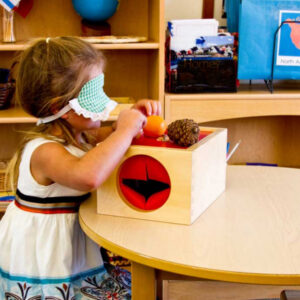 Sensorial activities assist Toddlers in the great task of organizing, integrating and learning about their sensory input. The sensorial materials are designed to simplify learning and awareness of the environment by isolating difficulty; isolating the senses; encouraging mastery through repetition; possessing self-correction within the material; and presenting an attractive appearance to the child.
Sensorial activities assist Toddlers in the great task of organizing, integrating and learning about their sensory input. The sensorial materials are designed to simplify learning and awareness of the environment by isolating difficulty; isolating the senses; encouraging mastery through repetition; possessing self-correction within the material; and presenting an attractive appearance to the child.
The goals of the Sensorial area are to strengthen and refine each of the child’s senses and pincer grasp, develop the organization and patterning skills inherent in math and language concepts that build upon the sensory awareness stimulated by these materials.
![]()
 These are the first exercises introduced to the children. They create the foundation upon which all other work in the classroom depends. Practical Life exercises include care of self and the environment, as well as the development of large and fine motor control. These practical experiences in everyday activities are the cornerstone of the Montessori Method.
These are the first exercises introduced to the children. They create the foundation upon which all other work in the classroom depends. Practical Life exercises include care of self and the environment, as well as the development of large and fine motor control. These practical experiences in everyday activities are the cornerstone of the Montessori Method.
The focus of the Practical Life area is to develop coordination, independence, a sense of order, and above all, concentration.
![]()
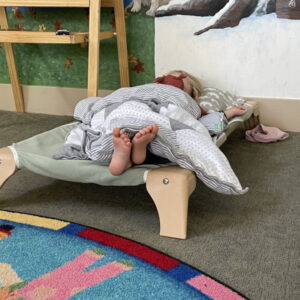 For those children enrolled in the full day schedule nap time will begin around 1:00PM following lunch, recess, and a pre-nap story time. LMM will provide a separate sleeping cot or a pop-out tent for each child.
For those children enrolled in the full day schedule nap time will begin around 1:00PM following lunch, recess, and a pre-nap story time. LMM will provide a separate sleeping cot or a pop-out tent for each child.
Families are welcome to provide their own tent, blanket/pillow, and special item that will assist their child in feeling comfortable to rest and settle down for the afternoon.
![]()
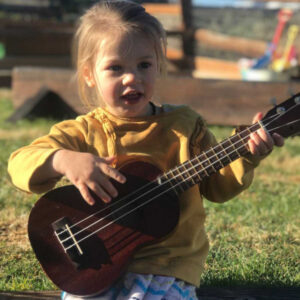 Music & Movement
Music & Movement• Singing
• Listening to music
• Instruments
• Recess/Playground
• Stretch & Grow Program
• Daily Nature Walks
• Paint, collage, play dough, stamping, color mixing
• Emphasize the process and not the product; encourage individuality
![]()
 The Cultural area of the Toddler Montessori classroom opens up a world of discovery into the many plants, animals and people around the planet. These lessons extend into the Practical Life, Sensorial, Math, and Language areas of the classroom and allow for further exploration with interesting and unique activities. The Toddler Cultural curriculum includes simple lessons in world music and art, geography, history, ecology, geology, botany, zoology, and the physical sciences.
The Cultural area of the Toddler Montessori classroom opens up a world of discovery into the many plants, animals and people around the planet. These lessons extend into the Practical Life, Sensorial, Math, and Language areas of the classroom and allow for further exploration with interesting and unique activities. The Toddler Cultural curriculum includes simple lessons in world music and art, geography, history, ecology, geology, botany, zoology, and the physical sciences.
The goals of Cultural area include exposing the child to a wide variety of subjects through “key experiences”; stimulating the child’s natural curiosity; providing a sensorial experience for key concepts; providing language and vocabulary for these subjects; and leading the child to an awareness of the interrelatedness and uniqueness of people, plants, and animals.
The Montessori classroom encourages exploration and curiosity to define a sense of self and the spirit of the people of the world.
• Presentation of the globe
• Our 7 continents
• World puzzle map
• Songs and stories from around the world
• Offer extensions according to the child’s interest such as the names of countries, flags, capitals, etc.
• Arrange experiences that expose the child to various world cultures through songs, food, books, clothing and artifacts.
• Care and respect for plants
• Living/non-living
• Parts of plants
• Parts, types and shapes of leaves
• Types and parts of fruits, vegetables, and seeds
• Plants around the world and in different biomes
• Care of and respect for all animals
• Classification of animals
• Parts of animals
• Animal habitats, diets, and life cycles
Physical Science:
• Sink verses float
• Magnets
• Magnetic vs. non-magnetic
• Nutrition and food groups
• Solid, liquid, gas
• Chemical reactions
• Oil and Water
Life Science:
• Nature Walks
• Plant care
• Animal care
• Living & non-living
• Life cycles
Earth Science:
• Land, Air & Water
• Types of rocks
• Volcanoes
• Seasons & weather
• The Moon, Sun and Stars
• Ecosystems
• Water Cycle
![]()
 To help prepare the mathematical mind, Toddlers are exposed to the world of numbers through counting games and concrete materials. These exercises encourage the development of important pre-math skills such as order, sequence, visual discrimination, sorting, one-to-one correspondence and directionality. Toddler Math activities include stacking and nesting cubes, number blocks and puzzles, sorting and counting materials.
To help prepare the mathematical mind, Toddlers are exposed to the world of numbers through counting games and concrete materials. These exercises encourage the development of important pre-math skills such as order, sequence, visual discrimination, sorting, one-to-one correspondence and directionality. Toddler Math activities include stacking and nesting cubes, number blocks and puzzles, sorting and counting materials.
• One to one correspondence (Knobbed Cylinders)
• Quantity 1-4 & 1-10
◦ Counting songs and books
◦ Counting fingers, animals, children, objects in the environment
◦ Spindle Boxes
◦ Sandpaper Numerals
◦ Number tracing in sand
◦ Cards and Counters
◦ Association of written symbol with quantity
• Circle, square, triangle
• Geometric solids: cube, sphere, pyramid
• Daily routine
• Periods of the day (morning, afternoon, evening)
• Seasons
![]()
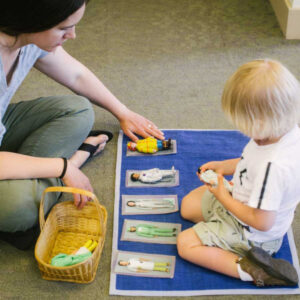 Around the age of two, children’s speech development experiences an explosion of words, soon followed by sentences. The Language materials in the Toddler classroom encourage the refinement and enrichment of language as the first steps on the road to writing and finally reading. Early Language materials and oral exercises like storytelling and reading aloud support the toddler’s need to be immersed in language. Activities include books, puzzles, naming objects like fruits, vegetables and animals, and beginning sound games.
Around the age of two, children’s speech development experiences an explosion of words, soon followed by sentences. The Language materials in the Toddler classroom encourage the refinement and enrichment of language as the first steps on the road to writing and finally reading. Early Language materials and oral exercises like storytelling and reading aloud support the toddler’s need to be immersed in language. Activities include books, puzzles, naming objects like fruits, vegetables and animals, and beginning sound games.
• Matching cards
• Vocabulary cards
• Stories read aloud
• Size and shape discrimination exercises
• Picture-word cards
• Sorting
• Tracing objects
• Tracing shapes
• The Sandpaper Letters encourage assimilation of the form of letters into muscular memory through repeated tracing.
• Practical life and Sensorial Exercises encourage repeated use of the pincer grasp.
• The Sandpaper Letters are used to teach the formation and recognition of the letters of the alphabet. Montessori Method teaches the sound followed by the name of the letter.
• The Sandpaper Letters isolate the initial sound.
• Beginning sounds are introduced through games and exercises to encourage sound isolation.
• Object Boxes provide an opportunity for children to explore and learn how to write and spell many different of words.
• Countless opportunities are available for children to discover language through storytelling, songs, puzzles, matching, books and sorting exercises.
• Letter tracing in sand.
![]()
 Sensorial activities assist Toddlers in the great task of organizing, integrating and learning about their sensory input. The sensorial materials are designed to simplify learning and awareness of the environment by isolating difficulty; isolating the senses; encouraging mastery through repetition; possessing self-correction within the material; and presenting an attractive appearance to the child.
Sensorial activities assist Toddlers in the great task of organizing, integrating and learning about their sensory input. The sensorial materials are designed to simplify learning and awareness of the environment by isolating difficulty; isolating the senses; encouraging mastery through repetition; possessing self-correction within the material; and presenting an attractive appearance to the child.
The goals of the Sensorial area are to strengthen and refine each of the child’s senses and pincer grasp, develop the organization and patterning skills inherent in math and language concepts that build upon the sensory awareness stimulated by these materials.
• Pink Cubes
• Nesting Barrels
• Brown Prisms
• Color Tablets box 1 and 2
• Knobbed Cylinders
• Knobbless Cylinders
• Tactile Boards
• Fabric Box
• Baric Prisms
• Sensory Bins
• Distinguishing sounds that vary in pitch and volume through these materials:
◦ Sound Cylinders
◦ Musical Instruments
• Identifying basic tastes and learning the related language (salty, sweet, sour, bitter).
• Smelling Cylinders (this needs to be indented with round circle)
• Sorting and grading various Sensorial materials solely by touch through exploring these materials:
◦ Geometric solids
◦ Mystery Box
![]()
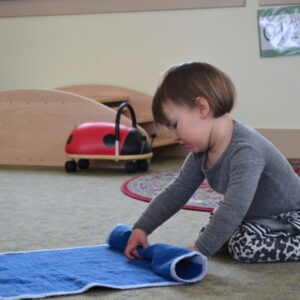 These are the first exercises introduced to the children. They create the foundation upon which all other work in the classroom depends. Practical Life exercises include care of self and the environment, as well as the development of large and fine motor control. These practical experiences in everyday activities are the cornerstone of the Montessori Method.
These are the first exercises introduced to the children. They create the foundation upon which all other work in the classroom depends. Practical Life exercises include care of self and the environment, as well as the development of large and fine motor control. These practical experiences in everyday activities are the cornerstone of the Montessori Method.
The focus of the Practical Life area is to develop coordination, independence, a sense of order, and above all, concentration.
• Control of movement
• Walking purposefully
• Making silence
• Bouncing and catching ball
• Riding tricycles
• Digging, raking, watering
• Climbing
• Wet and dry pouring
• Rolling a mat and pushing in chair
• Spooning, tweezing, scooping, squeezing
• Opening and closing using various containers
• Cutting, peeling, grating, serving various types of foods
• Sweeping the floor
• Cleaning & polishing
• Washing a window
• Washing dishes
• Caring for animals and plants
• Cleaning up classroom/playground
• Recycling
• Respect for self
• Personal care
• Hand washing
• Dressing frames
• Hanging up coat
• Putting on shoes
• Using the toilet
• Greeting someone
• “Please” and “Thank you”
• Waiting for turns
• Walking around the rug
• Helping others, sharing, caring for others
• Quiet voices and listening
![]()
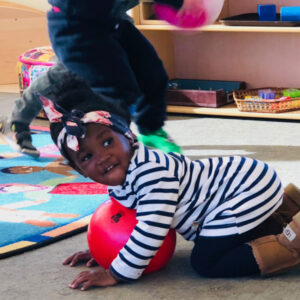 Little Miners has recently partnered our Toddler Program with Stretch-n-Grow of Utah! On Tuesdays and Wednesdays, our toddlers enjoy a 30-minute session of exercising with this fun company. Here is an excerpt from their website about Stretch-n-Grow:
Little Miners has recently partnered our Toddler Program with Stretch-n-Grow of Utah! On Tuesdays and Wednesdays, our toddlers enjoy a 30-minute session of exercising with this fun company. Here is an excerpt from their website about Stretch-n-Grow:
“Stretch-n-Grow is the world’s largest network of children fitness professionals who, each week,
teach over one hundred thousand children in hundreds of cities across 15 countries to “Exercise and Eat What’s Wise!”
Stretch-n-Grow offers EXERciting programs for kids starting as young as 18 months up to twelve years old. Each Stretch-n-Grow coach is a certified youth fitness specialist and has only one passion – to show our Stars an EXERciting time!”
For more information, please visit them on the web at http://stretch-n-grow.com/
